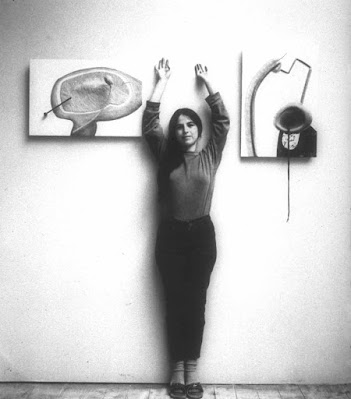January 11, 2021
A quote from the artist Eva Hesse: “Life doesn’t last; art doesn’t last. Born in Hamburg, Germany in 1938, and forced to flee the Nazis in 1938. her sister and Eva had to be separated from their parents and went to the Netherlands. Six months later, the family reunited, went to England, and then settled into Manhattan’s Washington Heights in 1939. Her parents separated, and her father remarried in 1945, but sadly Eva’s mom committed suicide in 1946. In 1969, Eva Hesse was diagnosed with a brain tumor, and she died in 1970. Her work as an artist lasted for a decade, and her death came at the age of 34.
At 18, she interned at “Seventeen” Magazine, while taking classes at Art Students League, and eventually to Yale University where she received her BA in 1959. At Yale, she studied under Josef Albers at that time, influenced by Abstract Expressionism. Back in Manhattan, she became a close friend to the artist Sol LeWitt. In the early 60s, she mostly did abstract drawings but then made these sculptures, made out of fiberglass, latex, and plastics. Her sculptures were delicate, textural, and sensual.
My understanding is that her work is challenging to preserve due to the material she used, beyond fiberglass. It seems latex ages, but then that’s Life. The quotation at the start of this essay, I think, is true. Still, I think it’s more about the nature of an idea of a piece and knowing that a material that one uses can not always last. Yet, for the moments it’s here, the work is fantastic. To preserve one’s history through a medium whatever it’s music, painting, sculpture, or cinema, there will always be the issue of how to maintain the work for future generations. Then again, I’m obsessed with the thought that art physically changes, as well as people. I don’t think art is meant to be frozen in time but lives in different formats and systems. It’s fantastic that I listened to music from the radio, then the vinyl LP album, to CD, and now streaming. The same as seeing a movie in a theater, watching it on a VHS tape, and then DVD. The format changes art. When we see a painting in person, it’s nothing like seeing that same painting in a magazine or book. The texture is different.
With respect to my writing, I consistently edit and rearrange the text as time marches on. I feel work is never finished. Except when the artist/writer dies, then the work is completed. Curators and museums have a knack for showing old art as if something new. You put a work of art that is familiar to the viewer, but it’s next to an obscure piece of that artist, then the context can change. LeWitt mentions that his good friend wanted her art to be preserved, and more likely it will, but then again, it’s like re-doing that piece. Art does die, but it never stops and moves on to other platforms, but nothing is ever the same.




















No comments:
Post a Comment